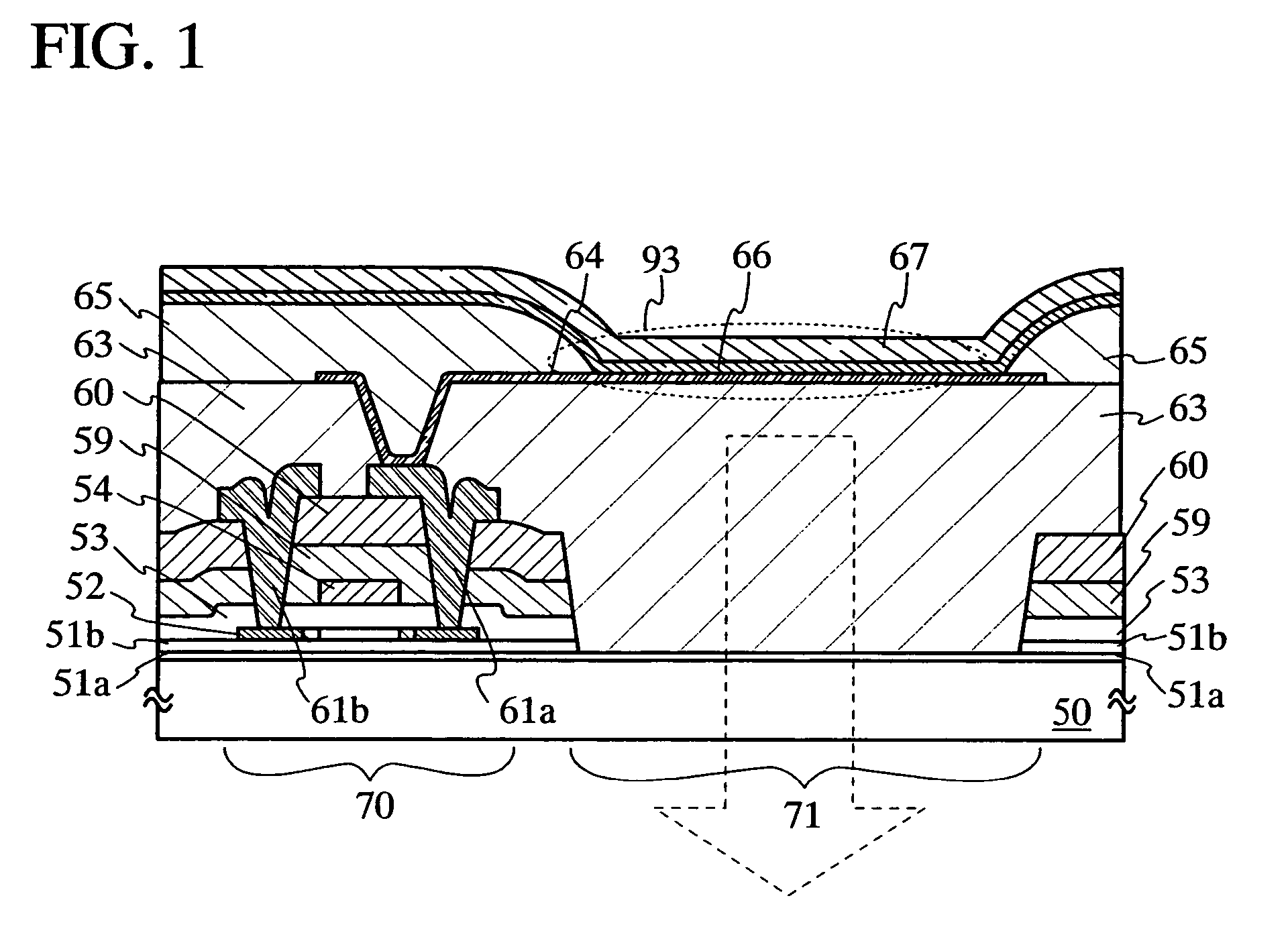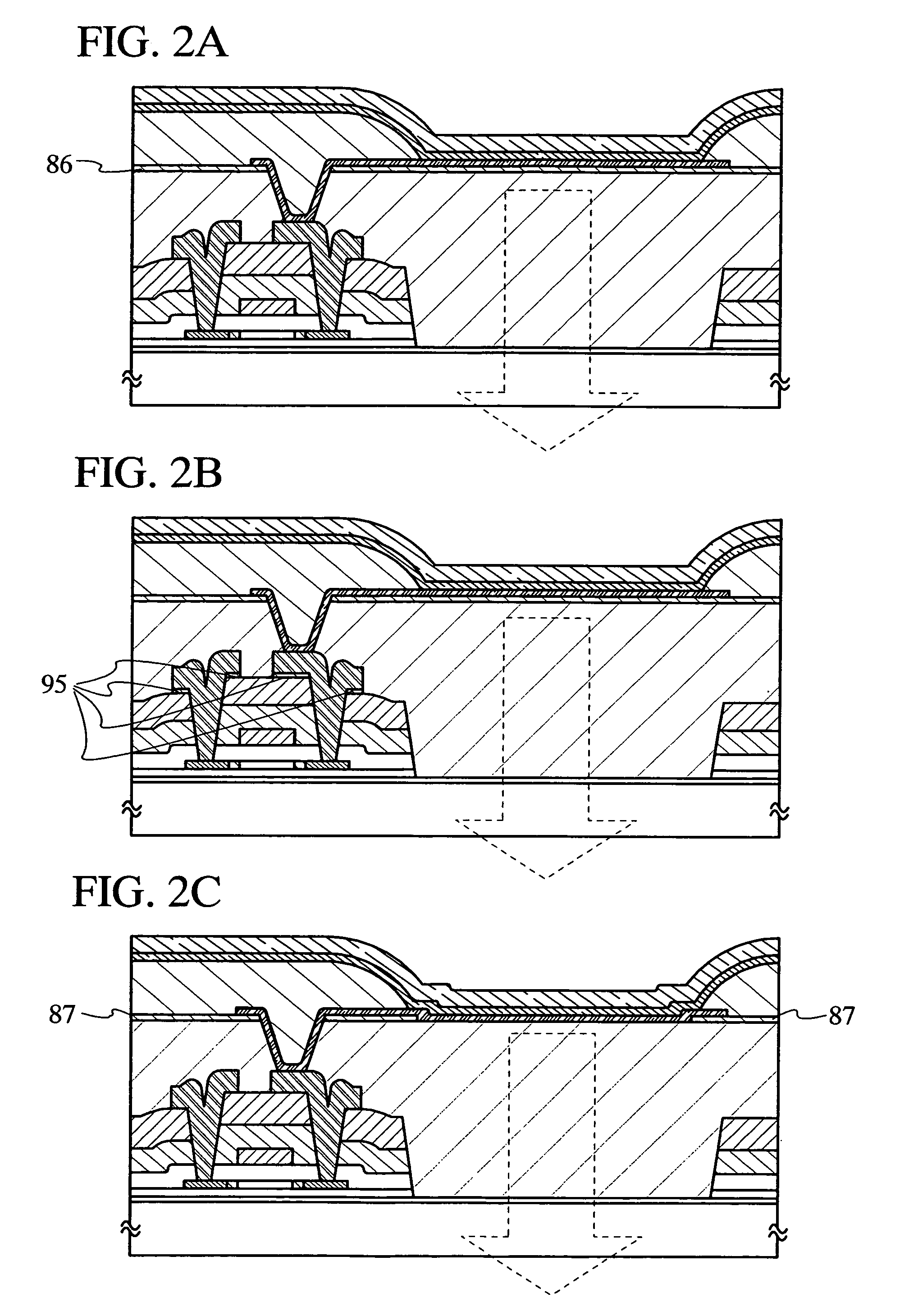Light emitting device
a light emitting device and active matrix technology, applied in the direction of solid-state devices, electric lighting sources, electric light sources, etc., can solve the problems of deterioration of image visibility
- Summary
- Abstract
- Description
- Claims
- Application Information
AI Technical Summary
Benefits of technology
Problems solved by technology
Method used
Image
Examples
embodiment mode 1
[0029]A light emitting device of the present invention will be described with reference to FIG. 1. A first base insulating layer 51a and a second base insulating layer 51b are provided over a substrate 50. A thin film transistor 70 including a semiconductor layer 52, a gate insulating layer 53 and a gate electrode 54 is formed on the second base insulating layer 51b. Also, the thin film transistor 70 is covered with an insulating film (a hydrogenated film) 59 and a first interlayer insulating layer 60. A connection portion (wiring) 61a and a wiring 61b that also serve as a source electrode and a drain electrode of the thin film transistor 70 are formed on the first interlayer insulating layer 60. The connection portion 61a and the wiring 61b are partly and electrically connected to the semiconductor layer 52 through contact holes passing through the insulating film (hydrogenated film) 59, the first interlayer insulating layer 60 and the gate insulating layer 53. A second interlayer ...
embodiment mode 2
[0052]In this embodiment mode, another structures of the invention will be shown in FIGS. 2A to 2C. The structures described in this embodiment mode exhibit same effect as that of the structure described in Embodiment Mode 1. Characteristics of the respective structures will be described below. Further, portions identical to those of FIG. 1 are not denoted by the reference numerals, and will not be further explained. Refer to FIG. 1 and Embodiment Mode 1 for more information about the portions.
[0053]As shown in FIG. 2A, an insulating layer 86 made from a material different from that of the second interlayer insulating layer 63 may be formed on the second interlayer insulating layer 63. The insulating layer 86 is made from a silicon nitride film or the like. This insulating layer 86 serves to prevent the second interlayer insulating layer 63 from being etched in etching the first electrode 64 of the light emitting element 93 and serves to prevent ingress of moisture etc., which adver...
embodiment mode 3
[0058]Another embodiment mode of the invention will be described in FIGS. 3A to 3C. The structures as shown in the present embodiment mode exhibit same effect as that of Embodiment Mode 1. Characteristics of the respective structures will be described below. Further, portions identical to those of FIG. 1 are not denoted by the reference numerals and will not be further explained. Refer to FIG. 1 and Embodiment Mode 1 for more information about the portions.
[0059]FIGS. 3A to 3C show cases where insulating layers 80, 82 and 84 are formed on each connection portion 61a and each wiring 61b. These insulating layers are used as passivation films for preventing active layers of the thin film transistors from an impurity. Therefore, a film mainly containing silicon nitride with an excellent passivation property is used as these insulating films. However, they may be formed of other material.
[0060]When forming the insulating layer 80, 82 or 84, if a refractive index of the insulating layer i...
PUM
 Login to View More
Login to View More Abstract
Description
Claims
Application Information
 Login to View More
Login to View More - R&D
- Intellectual Property
- Life Sciences
- Materials
- Tech Scout
- Unparalleled Data Quality
- Higher Quality Content
- 60% Fewer Hallucinations
Browse by: Latest US Patents, China's latest patents, Technical Efficacy Thesaurus, Application Domain, Technology Topic, Popular Technical Reports.
© 2025 PatSnap. All rights reserved.Legal|Privacy policy|Modern Slavery Act Transparency Statement|Sitemap|About US| Contact US: help@patsnap.com



